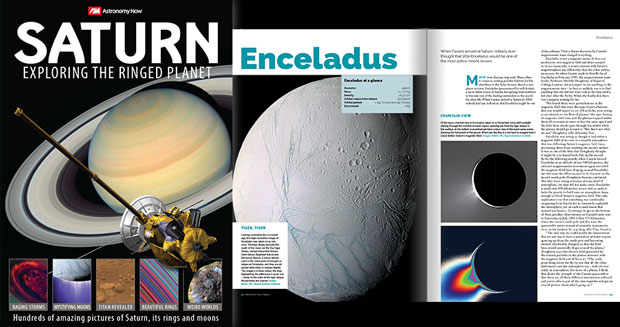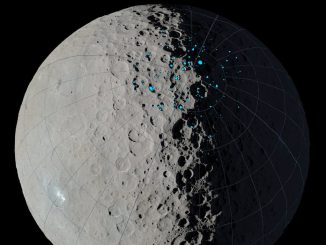
Launched in 1997, Cassini has been touring the Saturn system since arriving there in 2004 for an up-close study of the planet, its rings and moons. During its journey, Cassini has made numerous dramatic discoveries, including a global ocean within Enceladus and liquid methane seas on Titan.
Between 30 November 2016 and 22 April 2017, Cassini will circle high over and under the poles of Saturn, diving every seven days — a total of 20 times — through the unexplored region at the outer edge of the main rings.
“We’re calling this phase of the mission Cassini’s Ring-Grazing Orbits, because we’ll be skimming past the outer edge of the rings,” said Linda Spilker, Cassini project scientist at NASA’s Jet Propulsion Laboratory, Pasadena, California. “In addition, we have two instruments that can sample particles and gases as we cross the ring plane, so in a sense Cassini is also ‘grazing’ on the rings.”
On many of these passes, Cassini’s instruments will attempt to directly sample ring particles and molecules of faint gases that are found close to the rings. During the first two orbits, the spacecraft will pass directly through an extremely faint ring produced by tiny meteors striking the two small moons Janus and Epimetheus. Ring crossings in March and April will send the spacecraft through the dusty outer reaches of the F ring.
“Even though we’re flying closer to the F ring than we ever have, we’ll still be more than 4,850 miles (7,800 kilometres) distant. There’s very little concern over dust hazard at that range,” said Earl Maize, Cassini project manager at JPL.
So many sights to see
Cassini’s ring-grazing orbits offer unprecedented opportunities to observe the menagerie of small moons that orbit in or near the edges of the rings, including best-ever looks at the moons Pandora, Atlas, Pan and Daphnis.
Grazing the edges of the rings also will provide some of the closest-ever studies of the outer portions of Saturn’s main rings (the A, B and F rings). Some of Cassini’s views will have a level of detail not seen since the spacecraft glided just above them during its arrival in 2004. The mission will begin imaging the rings in December along their entire width, resolving details smaller than 0.6 mile (1 kilometre) per pixel and building up Cassini’s highest-quality complete scan of the rings’ intricate structure.
The mission will continue investigating small-scale features in the A ring called “propellers,” which reveal the presence of unseen moonlets. Because of their airplane propeller-like shapes, scientists have given some of the more persistent features informal names inspired by famous aviators, including “Earhart.” Observing propellers at high resolution will likely reveal new details about their origin and structure.
And in March, while coasting through Saturn’s shadow, Cassini will observe the rings backlit by the Sun, in the hope of catching clouds of dust ejected by meteor impacts.
During these orbits, Cassini will pass as close as about 56,000 miles (90,000 kilometres) above Saturn’s cloud tops. But even with all their exciting science, these orbits are merely a prelude to the planet-grazing passes that lie ahead. In April 2017, the spacecraft will begin its Grand Finale phase.
After nearly 20 years in space, the mission is drawing near its end because the spacecraft is running low on fuel. The Cassini team carefully designed the finale to conduct an extraordinary science investigation before sending the spacecraft into Saturn to protect its potentially habitable moons.
During its grand finale, Cassini will pass as close as 1,012 miles (1,628 kilometres) above the clouds as it dives repeatedly through the narrow gap between Saturn and its rings, before making its mission-ending plunge into the planet’s atmosphere on 15 September. But before the spacecraft can leap over the rings to begin its finale, some preparatory work remains.
To begin with, Cassini is scheduled to perform a brief burn of its main engine during the first super-close approach to the rings on 4 December. This manoeuvre is important for fine-tuning the orbit and setting the correct course to enable the remainder of the mission.
“This will be the 183rd and last currently planned firing of our main engine. Although we could still decide to use the engine again, the plan is to complete the remaining manoeuvres using thrusters,” said Maize.
To further prepare, Cassini will observe Saturn’s atmosphere during the ring-grazing phase of the mission to more precisely determine how far it extends above the planet. Scientists have observed Saturn’s outermost atmosphere to expand and contract slightly with the seasons since Cassini’s arrival. Given this variability, the forthcoming data will be important for helping mission engineers determine how close they can safely fly the spacecraft.
Saturn: Exploring the Ringed Planet
Find out more about Saturn and its moons in this 196-page special edition from Astronomy Now. [geot exclude_region=”US” ]Order from our online store.[/geot][geot region=”US” ]Order from our online store.[/geot]




